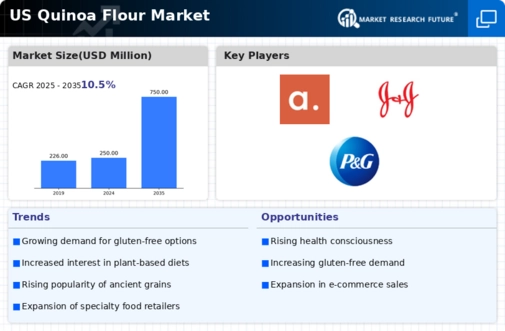The quinoa flour market exhibits a dynamic competitive landscape characterized by a blend of innovation, sustainability, and strategic partnerships. Key players such as Bob's Red Mill (US), Alter Eco (US), and Andean Naturals (PE) are at the forefront, each adopting distinct strategies to enhance their market presence. Bob's Red Mill (US) focuses on product diversification and organic certifications, appealing to health-conscious consumers. In contrast, Alter Eco (US) emphasizes sustainability through fair trade practices and eco-friendly packaging, which resonates with environmentally aware customers. Andean Naturals (PE) leverages its direct sourcing from South American farmers, ensuring quality and authenticity, thereby strengthening its brand positioning in the premium segment. Collectively, these strategies contribute to a competitive environment that prioritizes quality, sustainability, and consumer engagement.
The business tactics employed by these companies reflect a commitment to optimizing supply chains and localizing manufacturing processes. The market structure appears moderately fragmented, with several players vying for market share while also collaborating on sustainability initiatives. This fragmentation allows for niche players to thrive, yet the influence of major companies remains substantial, shaping consumer preferences and driving innovation.
In October 2025, Bob's Red Mill (US) announced the launch of a new line of gluten-free quinoa flour products, aimed at expanding its offerings to cater to the growing demand for gluten-free alternatives. This strategic move not only enhances their product portfolio but also positions the company to capture a larger share of the health-conscious consumer segment. The introduction of these products is likely to bolster brand loyalty and attract new customers seeking gluten-free options.
In September 2025, Alter Eco (US) unveiled a partnership with a leading environmental organization to promote sustainable farming practices among quinoa farmers in South America. This initiative underscores the company's commitment to sustainability and ethical sourcing, potentially enhancing its brand reputation and consumer trust. By aligning with environmental goals, Alter Eco (US) may strengthen its market position and appeal to a demographic increasingly concerned with the ecological impact of their food choices.
In August 2025, Andean Naturals (PE) expanded its distribution network within the US by partnering with major health food retailers. This strategic expansion is indicative of the company's intent to increase its market penetration and accessibility to consumers. By enhancing its distribution capabilities, Andean Naturals (PE) is likely to improve its competitive edge, ensuring that its products reach a broader audience.
As of November 2025, the quinoa flour market is witnessing trends that emphasize digitalization, sustainability, and technological integration. Companies are increasingly leveraging digital platforms for marketing and distribution, while sustainability remains a core focus, influencing consumer purchasing decisions. Strategic alliances are becoming pivotal in shaping the competitive landscape, as companies collaborate to enhance their sustainability efforts and product offerings. Looking ahead, competitive differentiation is expected to evolve, with a shift from price-based competition to a focus on innovation, technology, and supply chain reliability, ultimately redefining market dynamics.

















Leave a Comment